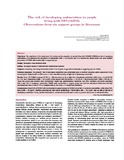The risk of developing malnutrition in people living with HIV/AIDS: observations from six support groups in Botswana

View/
Date
2009Author
Nnyepi, M.S.
Publisher
Medpharm Publications (Pty) Ltd., http://www.medpharm.co.zaType
Published ArticleMetadata
Show full item recordAbstract
Objectives: The objectives of this study were to 1)to determine the proportion of people living with HIV/AIDS (PLWHA) at risk of developing malnutrition, 2) to determine the prevalence of malnutrition (BMI < 18.5 kg/m2, and 3)to describe the dietary intake and other nutrition parameters of PLWHA with membership in support groups.
Design: Descriptive cross-sectionals study.
Setting: Six support groups in Gaborone and neighboring locations.
Subjects: Consenting, free- living HIV-positive adults 20-50 years of age with membership in support groups PLWHA.
Outcome measures: The subjects' risk of developing malnutrition was established using a modified subjective global assessment (SGA)screening tool. Subjects with an SGA score ≥ 4 were classified as being at high risk of developing malnutrition. Results: From 145 PLWHA screened, 47.5% (n=69)were found to be at high risk of developing malnutrition (SGA score ≥ 4) and 28.5%(n=41) were malnourished (BMI <18.5 kg/m2). In the sample with SGA scores ≥ 4, 52.2% (n=35) presented with BMI <18.5 kg/m2. These two groups also reported more unintentional weight loss, gastrointestinal symptoms, and other conditions commonly associated with a high risk of developing malnutrition. PLWHA with membership in support groups also had low educational attainment and high unemployment rates. A total of 47% of subjects with an SGA score ≥ 4 needed food assistance. Conclusions: Almost 50% of PLWHA with membership in support groups for PLWHA are at risk of developing malnutrition, while about 30% have a BMI <18.5 kg/m2. Nutrition screening can also help to identify those PLWHA with BMI>18.5 kg/m2 who are still at high risk of developing malnutrition. Timely nutrition interventions can therefore be instituted in order to prevent deterioration in nutritional status.
